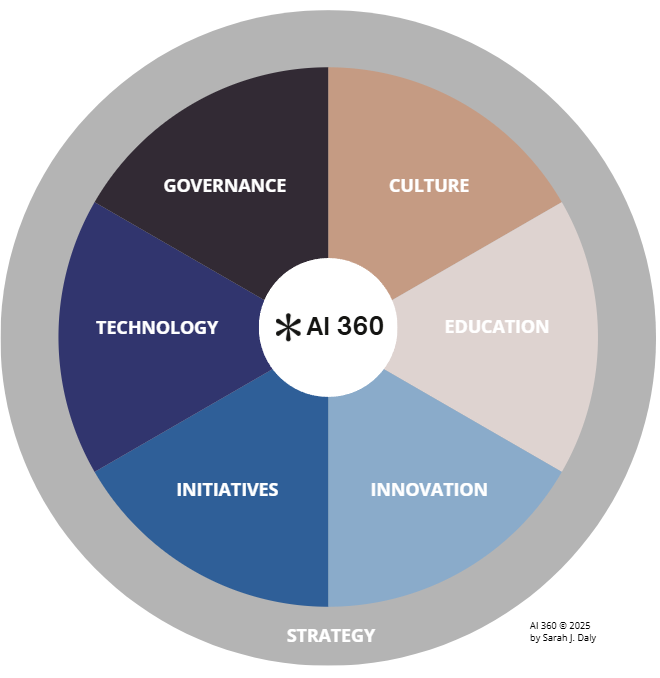The 10 AI Capability Tests
What is organisational AI capability, and do you have it? These ten tests help leaders evaluate the strength of their AI capability, and where the gaps might be. Each test draws from the AI360 Framework and reflects a critical condition for mature, effective AI adoption.
Understanding your organisational AI capability will help to shape your path forward.
What Is AI Capability?
AI capability is the ability of an organisation to adopt and apply artificial intelligence in a way that’s effective, responsible, and aligned with its strategic priorities.
It includes more than just data science or experimentation. True capability requires the right foundations across governance, culture, education, innovation, initiatives, and technology—each working together to enable meaningful progress, not isolated activity.
In the AI360 Framework, these six areas sit within the broader context of organisational strategy. This reflects a simple truth: AI is not an add-on. Its use should be shaped by the direction, constraints, and goals of the business as a whole.
AI capability vs. AI adoption
AI adoption refers to the observable use of AI tools, systems, or processes across an organisation. This includes pilots, operational deployments, and the day-to-day application of AI technologies in specific business functions.
AI capability, on the other hand, is the underlying organisational ability to adopt and apply AI effectively and sustainably. It encompasses governance, culture, skills, systems, innovation pathways, and alignment to strategic goals.
The relationship: AI capability enables AI adoption to succeed.
Without capability, adoption often remains superficial, confined to isolated pilots or short-lived tools. With strong organisational capability, adoption becomes scalable, responsible, and strategically valuable.
Common challenges
Many organisations move to adopt or scale AI before developing the foundational capability. This frequently leads to:
Disconnected or uncoordinated pilots ("pilot purgatory")
Resistance from teams or lack of engagement
Poor return on investment
Heightened ethical, reputational, or compliance risk
The 10 AI Capability Tests will help you think through your next steps.
The 10 AI Capability Tests
1. The Alignment Test: Is your AI agenda clearly linked to your overall business strategy?
If AI use cases don’t support your core goals—whether cost, growth, customer outcomes, or risk management—you’re solving the wrong problems.
AI360 Pillars: Strategy, Initiatives
2. The Governance Test: Are there clear, accountable guardrails for how AI is used in your organisation?
AI without governance is a liability. Who decides where it’s applied, how it’s monitored, and what risks are acceptable?
AI360 Pillars: Governance
3. The Cultural Readiness Test: Do your people trust, understand, and feel safe engaging with AI?
Adoption won’t scale if people fear job loss, ethical breaches, or simply don’t see the value. Culture is either your greatest enabler—or your biggest blocker.
AI360 Pillars: Culture
4. The Leadership Ownership Test: Is AI leadership embedded beyond the tech team?
If AI is only discussed in data science or IT forums, you’re not building enterprise capability. Executives must own the AI conversation.
AI360 Pillars: Governance, Strategy, Culture
5. The Literacy Test: Can your workforce use AI tools effectively and responsibly, today?
Not everyone needs to build models. But everyone should know how to engage with AI, ask the right questions, and make informed decisions.
AI360 Pillars: Education
6. The Innovation Pipeline Test: Do you have a way to identify, test, and scale promising AI ideas?
Many organisations are stuck in “pilot purgatory.” Capability means having a systematic path from idea to impact, not just isolated experiments.
AI360 Pillars: Innovation, Initiatives
7. The Technology Readiness Test: Is your infrastructure ready to support safe, scalable AI?
Even the best ideas won’t move if your data is fragmented or your systems and risk appetite can’t support experimentation.
AI360 Pillars: Technology, Governance
8. The Value Realisation Test: Are you measuring the impact of your AI initiatives?
If you can’t show ROI, directly linked to a business problem you are trying to solve, you won’t build confidence or sustain investment.
AI360 Pillars: Initiatives, Strategy
9. The Talent Design Test: Are you hiring and shaping roles with the future in mind?
Future-ready organisations don’t just train people, they also design roles that reflect where the work is going. This includes leadership, governance, and cross-functional fluency.
AI360 Pillars: Education, Culture, Strategy
10. The Resilience Test: Can your people, systems and processes adapt as the technology evolves?
AI moves fast and dynamic capability is needed to stay ahead. Capability means not only managing today’s tools, but having the strategic foresight, agility, and risk posture to adapt to what’s coming.
AI360 Pillars: Governance, Technology, Culture, Innovation, Strategy
What Do Your Answers Reveal?
How many of these capability tests could you confidently answer “yes” to?
Organisations that invest in all six domains of the AI360 Framework—Governance, Culture, Education, Innovation, Initiatives, and Technology—put themselves in the strongest position to use AI with strategic impact. Building capability doesn’t mean being perfect in every area from day one. But it does mean recognising where the gaps are and taking deliberate steps to close them.
The goal isn’t to move fast, it’s to move well. And that starts with knowing where you stand.
Want to understand and your AI capability?
If your organisation is thinking seriously about the role of AI, we’d be happy to connect for a short, no-obligation discussion. Often, a single conversation can help illuminate the next best step.
To learn more or book a time, send us a note here or reach out directly to sonia@ai360review.com.


